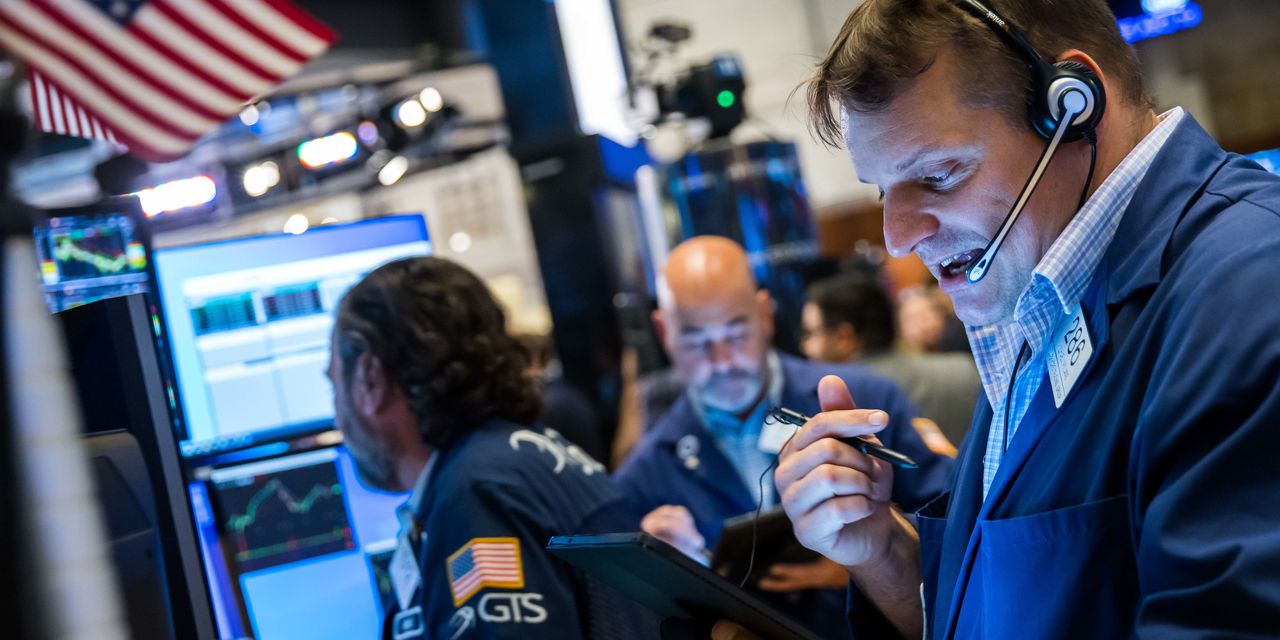The yield curve continues to signal a recession is on the way, but stock investors are looking further into the future.
For nearly a year, since last July, the chart plotting interest rates on U.S. Treasuries of different maturities has been downward sloping. It means yields on longer-term debt are lower than on shorter-term securities. That’s a reversal of the normal pattern known as an inversion of the yield curve. Longer-term rates are normally higher because there is generally more inflation and interest-rate uncertainty over the long term than in the short term, so bond investors tend to demand a higher yield to lend for longer.
An inverted yield curve can be a sign that investors expect higher interest rates or economic risk in the near term, and thus demand more compensation. An inverted yield curve has preceded every U.S. recession since the 1950s.
The yield on the 2-year Treasury note is more than a percentage point higher than that on 10-year debt, the largest gap since early March, in the wake of the failure of Silicon Valley Bank. The 6-month Treasury bill has the highest yield on the curve, at 5.45%—versus 3.71% for the 10-year note.
An inversion this big hasn’t happened since the 1970s and 1980s, another period of high inflation and rising interest rates that saw several recessions.
According to Dow Jones Market Data, inversions of the 2-year and 10-year yields have preceded recessions by as little as seven months or as much as two years, so a slump could well be coming to the U.S. relatively soon. A recession probability model from the New York Federal Reserve that uses the 3-month/10-year spread currently spits out a 71% likelihood of a recession in the next 12 months.
The inverted yield curve doesn’t say anything about the severity of a coming recession, however. The stock market’s resilience in 2023 despite the yield curve’s warning signal could be due to investors’ collective expectation that a potential recession later this year or in 2024 will be a shallow one. The worst of the regional banking mini-crisis appears to be in the rearview mirror, and there aren’t obvious signs of an asset bubble about to pop or an impending credit crunch.
The U.S. economy might suffer a couple of quarters of declining gross domestic product, but the downturn won’t be nearly as severe as recent recessions triggered by Covid-19 or the 2008-2009 financial crisis, the thinking goes, keeping corporate earnings aloft. Investors also appear to be confident that inflation will continue to decline toward the Fed’s 2% target over the coming quarters.
“The Treasury yield curve tells an important but incomplete story about the U.S. economy’s risk of imminent recession,” wrote DataTrek Research’s Nicholas
Colas.
“Monetary policy is purposefully tight at the moment because strong labor markets are still feeding inflationary pressures. That the 3m/10y and 2y/10y spreads are in very unusual territory is the Fed’s way of addressing that problem.”
The strength in the labor market that is fueling some of today’s inflation could blunt the impact of a slowing economy, Colas argues, resulting in a relatively short, mild recession. That is giving investors enough confidence to focus on the recovery on the other side—stocks are forward looking, after all—and ignore the yield curve’s warning.
“In our view, equity market investors are largely ‘looking through’ this classic recession signal,” wrote Wolfe Research’s Chris Senyek. As of Tuesday, the
S&P 500
was up 13% so far this year.
The yield curve could still steepen further and remain inverted for some time. Fed officials’ median forecast after their latest meeting suggested another half a percentage point of interest-rate increases this year, which could lift short-term Treasury yields even further. Meanwhile, several factors are keeping yields low for longer-dated debt.
“The long end of the curve is being held down relative to inflation due to excess liquidity in the markets and the high risk of secular global deflation resurfacing,” wrote Steven Ricchiuto, U.S. chief economist at Mizuho Securities USA. “China keeps falling short of growth expectations, and Covid did not reverse the excess supply of tradable goods in the global economy.”
Persistently low long-term rates also work against the Fed’s rate hikes, supporting a “higher for longer” stance by the Fed. Usually, the curve uninverts once a recession arrives as markets price in a greater likelihood of the Fed cutting its benchmark short-term interest rate to support the economy. But if the recession is shallow and inflation is still elevated, the Fed might be slower to cut, Ricchiuto wrote.
“This means the curve will stay inverted not just until the eventual recession begins, but through the duration of the contraction,” he said. “The degree of inversion is also likely to get worse as time goes on.”
An extended inversion would continue to pressure banks’ core business model of borrowing short to lend long—taking in customer deposits to extend mortgages, for example—but it isn’t bugging stock investors. They’re looking ahead to what comes next.
Write to Nicholas Jasinski at [email protected]
Read the full article here













